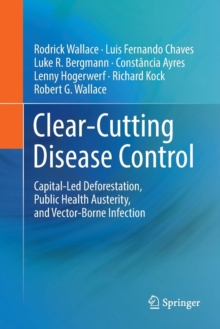Description
| Product ID: | 9783030102777 |
| Product Form: | Paperback / softback |
| Country of Manufacture: | GB |
| Title: | Clear-Cutting Disease Control |
| Subtitle: | Capital-Led Deforestation, Public Health Austerity, and Vector-Borne Infection |
| Authors: | Author: Constancia Ayres, Rodrick Wallace, Robert G. Wallace, Richard Kock, Luke R. Bergmann, Luis Fernando Chaves, Lenny Hogerwerf |
| Page Count: | 68 |
| Subjects: | Public health and preventive medicine, Public health & preventive medicine, Epidemiology and Medical statistics, Epidemiology & medical statistics |
| Description: | The vector-borne Zika virus joins avian influenza, Ebola, and yellow fever as recent public health crises threatening pandemicity. By a combination of stochastic modeling and economic geography, this book proposes two key causes together explain the explosive spread of the worst of the vector-borne outbreaks. Ecosystems in which such pathogens are largely controlled by environmental stochasticity are being drastically streamlined by both agribusiness-led deforestation and deficits in public health and environmental sanitation. Consequently, a subset of infections that once burned out relatively quickly in local forests are now propagating across susceptible human populations whose vulnerability to infection is often exacerbated in structurally adjusted cities. The resulting outbreaks are characterized by greater global extent, duration, and momentum. As infectious diseases in an age of nation states and global health programs cannot, as much of the present modeling literature presumes, be described by interacting populations of host, vector, and pathogen alone, a series of control theory models is also introduced here. These models, useful to researchers and health officials alike, explicitly address interactions between government ministries and the pathogens they aim to control. The vector-borne Zika virus joins avian influenza, Ebola, and yellow fever as recent public health crises threatening pandemicity. By a combination of stochastic modeling and economic geography, this book proposes two key causes together explain the explosive spread of the worst of the vector-borne outbreaks. Ecosystems in which such pathogens are largely controlled by environmental stochasticity are being drastically streamlined by both agribusiness-led deforestation and deficits in public health and environmental sanitation. As infectious diseases in an age of nation states and global health programs cannot, as much of the present modeling literature presumes, be described by interacting populations of host, vector, and pathogen alone, a series of control theory models is also introduced here. These models, useful to researchers and health officials alike, explicitly address interactions between government ministries and the pathogens they aim to control. |
| Imprint Name: | Springer Nature Switzerland AG |
| Publisher Name: | Springer Nature Switzerland AG |
| Country of Publication: | GB |
| Publishing Date: | 2019-01-26 |


